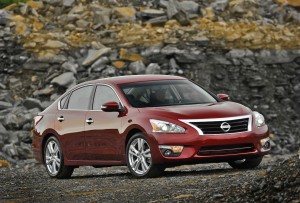
Automatic Emergency Braking, or AEB, is designed to step in when a driver misses a potential collision.
Nissan plans to more than double the number of vehicles it will sell in the U.S. for the 2018 model-year equipped with Automatic Emergency Braking, or AEB, a technology industry, insurance and federal regulators believe will significantly reduce the number of crashes on U.S. roadways.
In all, AEB will come standard on “more than 1 million vehicles” in the coming year, up from 450,000 in 2017, the automaker announced this morning. The industry, in general, is rapidly expanding the use of the technology which is designed to slow, or even bring a vehicle to a stop, in the event of a potential crash a driver might not respond to rapidly enough.
“The big news here is that we’re making AEB standard across all grades of our best-selling models,” said Michael Bunce, vice president, Product Planning, Nissan North America, Inc. “This increased AEB availability is part of our ongoing commitment to help reduce fatalities while realizing our comprehensive vision of Nissan Intelligent Mobility.”
The automaker added that the technology will now be standard on:
- Rogue and Rogue Sport,
- Altima,
- Murano,
-
LEAF (which will see a complete redesign for 2018),
- Pathfinder,
- Maxima, and
- Sentra.
The exceptions are except manual transmission-equipped and all NISMO versions of these vehicle lines. Select versions of the big Nissan Armada SUV now will come with standard AEB, as well.
(Delphi, Transdev set to launch French autonomous vehicle pilot in late ’17. Click Here to see what it will do.)
Automatic Emergency Braking is a next-step update of forward collision warning, a technology that uses radar and/or vision technology to monitor the road ahead of a vehicle. FCW sounds an alert if it senses a potential collision. AEB goes the next step, first sounding an alert and then, if the driver doesn’t quickly and adequately react, applying the brakes automatically.
Several studies, including one by the Insurance Institute for Highway Safety, have shown that vehicles equipped with either of these systems are less likely to be involved in crashes, especially low-speed incidents in heavy traffic situations – though AEB delivered the most notable reduction.
(Teens three times more likely to die in car crashes than older drivers. Click Here for the full story.)
Noting a one-third reduction in crashes requiring police intervention, meanwhile, the National Highway Traffic Safety Administration in 2015 formed a precedent-setting alliance with 20 automakers – including Nissan — to look for ways to make AEB standard equipment. The goal was to move faster than might be possible through the normal regulatory process.
Calling it “a win” for consumers,” former U.S. Transportation Secretary Anthony Foxx announced in March 2016 that virtually all new cars, trucks and crossovers sold in the U.S. will be equipped with automatic emergency braking by September 2022. But a number of those makers have been accelerating the rollout of AEB, the Nissan announcement the latest example.
Nissan and other automakers also have agreed to join an industry-government consortium aimed at encouraging the development and implementation of other advanced safety systems over the coming years.
(Click Here to see why pedestrian deaths hit a new high in 2016.)



Gee, I wonder why cars are getting so expensive. So the idiots out there can text without worry.